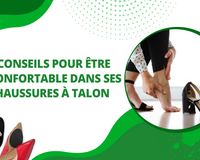
You'll know how important it is to use the right good pair of shoes for metatarsalgia when suffering from metatarsalgia pain. Being an intense pain, metatarsalgia affects the soles of the feet, and the use of unsuitable footwear can worsen the situation.
So it's very important to find the right footwear for metatarsalgia, one that not only provides good support and comfort, but is also easy to wear. support for the foot, but also adequate arch relief. To this end, there are several different types of footwear for people suffering from metatarsalgia-related pain, ranging from specialized orthopedic shoes to comfortable orthopedic insoles.
What is metatarsalgia?

Perceived as a pain that can affect the foot, metatarsalgia generally occurs at the front of the foot, more precisely near the toes. The pain caused is due to pressure exerted on the long bones or metatarsals located at front of the foot.
Metatarsalgia can be difficult to treat, and can manifest itself as a dull pain or tenderness, a burning sensation, and particularly when wearing shoes or taking a long walk. Metatarsalgia can affect anyone, although it is much more common in women.
The pain it causes can be very painful and disabling, which is why it's so important to understand what it is and what causes it. The most common causes of metatarsalgia are..:
- Overweight,
- Overuse of the feet,
- Inappropriate footwear,
- injuries or anatomical anomalies.
Generally speaking, people suffering from metatarsalgia tend to wear shoes that are unsuitable for their feet, and to adopt incorrect postures.
Shoes that are too large or too small can lead to metatarsalgia. excessive pressure on the metatarsalsThis can lead to pain and inflammation of the arch of the foot.
How to choose the right shoe for metatarsalgia?

It's important to know that finding the rightaussures for metatarsalgia can be a real challenge if you suffer from metatarsalgia and don't know which shoes to choose.
However, choosing the right metatarsalgia shoes is essential to fighting pain and preventing injury. Fortunately, at Smarfeetthere are several types of metatarsalgia shoes designed specifically for this condition.
The right shoe for metatarsalgia should have the following features:
✅A padded, removable insole for extra support and shock absorption.
✅A low heel to reduce pressure on the metatarsals.
✅A non-slip outsole for better grip.
In addition, you should avoid shoes with pointed or high heels, as these put extra pressure on the metatarsals.
Other treatments to relieve metatarsalgia pain

In addition to the choice of metatarsalgia shoes, there are many other treatments available to relieve and combat metatarsalgia pain. In fact, for patients suffering from metatarsalgia-related pain, a medical treatment can often be envisaged.
However, if medical treatment fails, surgery can help to restore a natural distribution of pressure on the ground and relieve plantar pain.
How is metatarsalgia treated?
The following non-invasive treatments may be necessary to treat metatarsalgia:
- Use of orthopedic insoles.
- Physiotherapy.
Orthotics for metatarsalgia: what you need to know

Orthotics for metatarsalgia are devices designed to distribute the body's weight over the foot, and to relieve pressure and pain on the long bones or metatarsals.
These insoles can be custom-made or bought off-the-shelf. Smarfeetand are usually padded for extra support and shock absorption.
So, if you suffer from pain caused by metatarsalgia, orthotics can help you to improve posture and promote a better distribution of support between the heel and toes of your foot.
Characteristics of insoles for metatarsalgia
Since they are designed to distribute the body's weight evenly over the foot, and provide additional support for the metatarsals of the foot, insoles for metatarsalgia should also be padded to absorb shock and cushion the pressure exerted on the metatarsals during intense activities such as running.
In addition, these insoles for metatarsalgia should also have a non-slip outsole for better grip, as well as a low heel to reduce pressure on the metatarsals.
Treating metatarsalgia with physiotherapy
In addition to the use of orthotics for metatarsalgia, kinesitherapy is also a useful type of treatment for relieving metatarsalgia-related pain. at the very least, it helps strengthen the foot muscles and improves posture.
However, physiotherapy can also help to eliminate symptoms inflammation and muscle tension most often associated with metatarsalgia.
Metatarsalgia surgery
In certain extreme cases, i.e. when the above treatments have failed, metatarsalgia may require surgical intervention. Surgical interventions for metatarsalgia may include fusion of the metatarsophalangeal joints or reduction of the metatarsal bones.
However, while surgery can help improve foot mobility and function, and relieve the pressure and pain associated with metatarsalgia, there are 2 types of surgical intervention:
- Minimally invasive osteotomy: The aim of this type of surgery is to reduce pressure and pain on the metatarsals. It is a minimally invasive procedure that involves removing a small part of the metatarsal bone.
- The Weil osteotomy: This procedure can be used when other treatments have failed to produce the desired results. This type of surgery involves implanting a screw into your foot to shorten or elevate the metatarsal heads.
Following this procedure, you'll be able to walk straight away, while being fitted with a orthopedic shoe for a few weeks.
Metatarsalgia: exercises to combat pain
Getting rid of the pain caused by metatarsalgia can also be achieved through a series of exercises. For this reason:
- Stand in a walking position with the leg to be stretched straight behind you and the other leg bent in front of you.
- Lean against a wall or chair.
- Bend your body forward and down until you feel the stretch in the calf of the outstretched leg.
- Hold the position for 20-30 seconds, or as long as pain permits, then relax.
Conclusion
Metatarsalgia can be bothersome and very painful, but there are ways of preventing it. shoes for metatarsalgia that can help relieve pain and give you more support. Consider ergonomic design, extra cushioning and curved soles.
Before buying a pair of shoes for metatarsalgia, you should also consider the type of shoes you normally wear. Once you've found the right type of shoes, make sure they fit properly and are comfortable.









